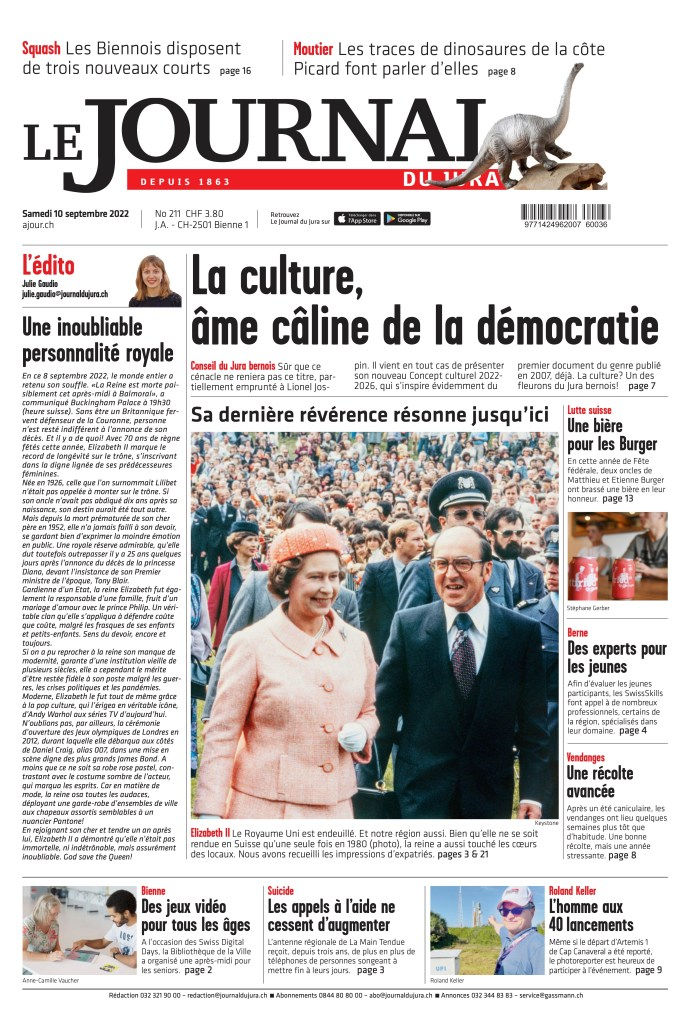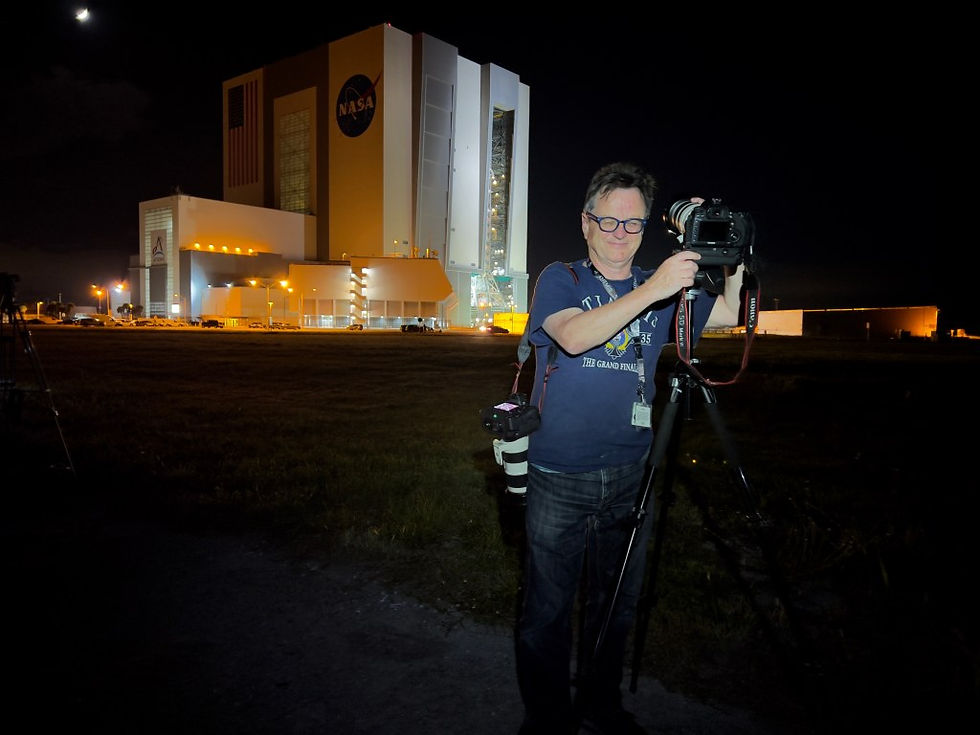Pas de tir
- Roland J. Keller

- 10 sept. 2022
- 7 min de lecture
Dernière mise à jour : 21 août 2024
Pas de tir ! C’est le titre évocateur de l’article de Dan Steiner, rédacteur en chef adjoint du Journal du Jura, qui me fait beaucoup d’éloges dans son article remarquablement rédigé et dont je remercie vivement.
[Cape Canaveral, September 10, 2022] – Pour mes lecteurs américains et anglophones, ainsi que pour la NASA qui m’accrédite, je l’ai traduit ci-dessous. Dans la langue française, le « Pas de tir », autrement PAD (dans le jargon US), a un double sens : « pas de tir », car il n’y en a pas et « pas de tir », autrement dit un « pas » (socle) pour lancer des fusées.
Le Journal du Jura, c’est un quotidien du Nord de la Suisse qui a une grande audience francophone au-dessus et autour de la ville de Bienne. Ce quotidien fait partie d’un groupe média étendu qui comprend une chaîne TV, TeleBilingue, une radio, Canal 3 et un autre quotidien, Bieler Tagblatt.

Journal du Jura - 10 septembre 2022

Journal du Jura - 10 septembre 2022
Site web : www.ajour.ch
Je retourne aux USA pour le lancement le 23 septembre Ah, au fait. La NASA a annoncé lors d’une télé-conférence viser un test cryogénique de remplissage du réservoir d’hydrogène le 17 septembre 2022, afin de savoir si la réparation du joint défectueux est efficace. Si c’est le cas, elle envisagera de tenter de lancer la fusée SLS du 23 au 27 septembre. Pour cela, elle escompte avoir une extension sur le Flight Termination System (FTS). Mais cela est encore en attente. Le 23 septembre, la fenêtre de lancement de 120 min (dont 80 après le lever du Soleil) commencerait à 6 h 47 du matin (12 h 47 en France). Le 27, cela serait à 11 h 37. (Source : Ciel & Espace)
Je serai au turbin en Suisse lundi 12 septembre, mais je vais revenir au lancement. Naturellement !
TOP-PAD, No START
No shot! This is the evocative title of the article by Dan Steiner, deputy editor of the Journal du Jura, who praises me in his remarkably well-written article and for which I am very grateful.
For my American and English-speaking readers, as well as for NASA, which accredits me, I have translated it below. In the French language, "Pas de tir", otherwise PAD (in US jargon), has a double meaning: "pas de tir", because there is none, and "pas de tir", otherwise a "step" (base) for launching rockets.

Dans l'attente de la sortie d'Artemis.
The Journal du Jura is a daily newspaper from the north of Switzerland with a large French-speaking audience above and around the city of Biel. This daily newspaper is part of an extended media group which includes a TV channel, TeleBilingue and a radio, Canal 3.
- Website: www.ajour.ch
I'm going back to the US for the launch on September 23
Oh, by the way. NASA announced during a teleconference to aim for a cryogenic test to fill the hydrogen tank on September 17, 2022, to see if the repair of the faulty seal is effective. If so, it will consider attempting to launch the SLS rocket on September 23-27. For that, it expects to have an extension on the Flight Termination System (FTS). But that is still on hold. On September 23, the launch window of 120 min (including 80 after sunrise) would begin at 6:47 am (12:47 am in France). On September 27, it would be at 11:37 a.m. (Source: Ciel & Espace)
I will be at work in Switzerland on Monday September 12, but I will be back at the launch. Of course I
Child of Pleigne and photojournalist in the Bernese Jura, Roland J. Keller is part of almost all space launches. Like the one, reported, of Artemis.
Roland J. Keller is a bit of a UFO in space photojournalism. Not that he necessarily believes in little green men. When we ask him what he thinks of those who insist on making their fellow men believe that the Earth is flat or that man has not put his boot on the Moon, he answers that they are dismantlers of history or jealous. "Criticism is easy, art is difficult," he says, while finding these reflections "stupid". Yes, or else he doesn't answer them. Maybe that's better.
No, the child of Pleigne, whose clichés are sometimes found in Le JdJ, but mostly in "La Semaine", is sometimes the only person accredited by NASA or SpaceX of Elon Musk who does not have an American passport. Surely, among the 40 launches that make up his record, not all have involved the European Ariane rockets, the Columbia shuttle or other famous American spacecraft. "It's so complicated to get accredited that I'm often the only Swiss to go there.
Russian Roulette
This was the case in Florida these days for the aborted propulsion of Artemis 1, the eponymous program launched by Donald Trump and supposed to bring a team back to lunar soil by 2025. The return of Roland J. Keller on Swiss soil is scheduled for Monday. But hampered by the failure of cooling an engine to nothing less than -251 ° C, the U.S. Space Agency had to delay several times this first mission, uninhabited. "Two postponements are not a lot," says the man who has been editor-in-chief of the "Swiss Technical Review" of the Swiss Engineering trade association since 2008. "I don't mind it too much. I'll have to come back," he laughs. Although he finances his trips himself but can work on the site for his monthly technical magazine, he believes that the most important thing is "to be on site and to experience the event. His budget? About 500 dollars per day.
But it's not enough to be able to access the launch pad at Cape Canaveral or Kourou, in French Guiana, for European spacecraft. It is still necessary that the programmed pictures are conclusive. This is because the journalists and photographers are not at their shooting posts during the launch. For Artemis 1 - whose launch is at best planned for September 23 - we are talking about propelling a 100 m high rocket weighing its small weight: 2600 t. Saturn 5, from the Apollo 11 program that took Neil Armstrong come back to the launching pads like the one in Florida, the reporter from the Jura explains that after leaving the media room, which is about 5 km away, the authorized persons are transported to the nature reserve from where they can adjust their camera. About 100 meters from the rockets. "We put them down about half a day before, then we go back to the media center, wait for the liftoff and, six hours after that one, we go back to goring, Edwin "Buzz" Aldrin and Michael Collins in direction of our natural satellite, in 1969, made, it, 3000 t.
to look for the devices. Then it looks like everything is burned, but no, it's just acidic water droplets, basically." And then shooting range photographer is a real job, he explains to us from Florida. Light must obviously be considered, but sometimes the adjustments are made at night for a morning or afternoon launch. A box is also there so that the camera takes the pictures at the right time... sound. "If it's too sensitive, it triggers when a bird flies by; if it's not sensitive enough, well, there's no triggering." For Artemis 1, and despite the postponement, the over-sensitivity of Roland J. Keller's setting still allowed him to get some nice shots of lightning streaking around the ship.
Through space projects, we can see the damage Earth ROLAND J. KELLER, SPACE PHOTOJOURNALIST
At Armstrong's Funeral
If he started to be interested in the space adventure, it is by watching Armstrong, whose funeral he attended, treading the lunar ground, from the top of his 13 years. "I was absolutely fascinated by the grandeur of the event. At the time, some 400,000 people worked for 10 years on the Apollo program. That's about 20,000 companies," he enthuses. "With Apollo, all of humanity embarked. Artemis is a renaissance, but more modern and slower, and with 20 times less budget. It's a shame to have waited 50 years.
All this remains quite impressive, but shouldn't we rather take care of the fate of the Earth? "Thanks to space projects, we can see the damage to the Earth," he answers. Ozone holes, satellite remote sensing. "The higher you go, the more you see cracks in dams, ocean pollution or the migration of aquatic fauna..." A matter of perspective.
THREE OUTSTANDING MEMORIES FROM HIS 40 LAUNCHES
April 12, 1981. Roland J. Keller remembers it as if it were yesterday. His first launch was also a revolution in the aerospace world. "Columbia: a rocket plane that went vertical. The Russians had tried it, but it never worked." The rocket plane explains our interlocutor, was like a truck in which one loaded satellite to send in space. "But it was much too expensive..."
Dramatic January 28, 1986. "The most striking event: the Challenger shuttle disaster. We were two Europeans on the spot. It was hard to live with, but not at the time. We didn't realize it until later." A little more than a minute after takeoff, the seals of a thruster, weakened by the predictable coolness of the weather, gave way and the explosion occurred. Seven dead. "It is unfortunate, but we were very much in demand by the media.
Helvetica December 19, 1999. "The launch of our astronaut, Claude Nicollier. The man from Vaud, already a member of the crew that had saved Hubble in 1993, was on his first and only mission consisting of extravehicular spacewalks, for the maintenance of the telescope. Roland Keller, who knew him well - "It's a small world" - had then flown with him in a Hunter Trainer (a fighter plane), over the Alps.










Commentaires